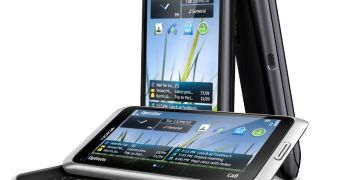In February, Espoo, Finland-based mobile phone maker Nokia announced a partnership with Microsoft, the result of which would be the adoption of Windows Phone on new Nokia smartphones.
Currently, Nokia is the largest handset vendor in the world, and the Symbian operating system it uses on its handsets enjoys the largest market share globally.
However, the Symbian platform has been losing ground lately in front of newcomers like Google's Android and Apple's iOS, as Nokia was unable to change the OS at the same fast pace that the new platforms changed.
As announced last month, Nokia will adopt Windows Phone as its primary mobile operating system, but it seems that it won't leave Symbian aside either, at least not for the time being. Contrary, the company plans new, high-end handsets running under the OS.
Currently, the company is working on the delivery of a major update for the platform, with a new user interface, a faster browser, improved performance in many areas, and the like.
As previously reported, the software update would arrive on the company's latest devices as the PR2.0 firmware, and is expected to be pushed out of Nokia's labs sometime this summer.
In a recent post, Purnima Kochikar, vice president, Forum Nokia, explains how the company plans on keeping the Symbian OS alive for the next few years, and talks about Nokia's commitment to its users.
“The first major update will arrive in summer, delivering a new home screen, new flexible widgets, new icons, a faster browser, new Navbar and a fresh look and feel to Ovi Store and Ovi Maps, including integration of social media services in Ovi Maps,” Kochikar says.
Nokia C7 Astound, the smartphone announced at CTIA Wireless this year, as being on its way to T-Mobile USA, comes with some of these enhancements loaded on it right from the start.
“Those plus the rest of the enhancements will be delivered to all users over the air in a simple update available from the Home Screen, and Nokia Astound users will receive the remaining enhancements not already in their device at the same time,” Kochikar explains.
Moreover, it seems that Nokia is also set to come to the market with a nice range of new, highly appealing devices running under the Symbian OS during the ongoing year, and beyond that.
The transition to Windows Phone would take some time, and the handset vendor plans a great Symbian roadmap for the time frame, namely for 2011 and 2012.
“These devices will take advantage of the strong integration of devices and services as well as our strength in areas such as imaging and location-based services. They will also include improvements in hardware performance such as GHz+ processing capabilities and faster graphics speeds,” Kochikar states.
At the same time, Nokia committed to supporting existing users of its Symbian-based devices for as long as necessary.
“Our intention is that when users come to the end of the natural lifecycle of their Symbian device they will make the change to a Nokia Windows Phone device and so it would not be in our interests to undermine their Nokia smartphone experience,” Kochikar continued.
Partner operators would also help during the transition period, he continued. Nokia is working at the moment with 109 operators in 34 countries.
“In many markets, including markets where Symbian is currently the lead smartphone platform with significant market share such as China, India, Russia and Turkey, we will continue to make our Symbian portfolio as competitive as possible while we work with Microsoft to introduce Windows Phone,” Kochikar said.
“For that reason certain markets will play a more significant role in selling the 150 million Symbian devices than others and we will be selling devices long after Windows Phone devices from Nokia have already started to appear in other markets. That is why we cannot give you the date when Symbian will no longer be supported.”
Application developers would also benefit from this, since they can still consider building applications for the OS, using Qt, the development platform for Symbian and future MeeGo technology, Nokia committed to the future development of this platform as well.

 14 DAY TRIAL //
14 DAY TRIAL //